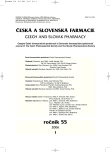Interconversion of Stereochemically Unstable Chiral Drugs: Utilization of Chromatographic Techniques for the Study of Enantiomerization Part II: Practical Applications
Authors:
A. Fedurcová; J. Lehotay; J. Čižmárik 1
Authors‘ workplace:
Univerzita Komenského v Bratislave, Fakulta chemickej a potravinárskej technológie, Katedra analytickej chémie, SR
; Univerzita Komenského v Bratislave, Farmaceutická fakulta, Katedra farmaceutickej chémie, SR
1
Published in:
Čes. slov. Farm., 2006; 55, 12-17
Category:
Review Articles
Overview
Enantiomerization is a first-order reaction; it means interconversion of one enantiomer into another (and vice versa). This phenomenon is a typical feature of some configurationally unstable chiral compounds and it complicates separation of racemic mixtures. For the study of enantiomerization, chromatographic separation techniques (GC, SFC, CE, MEKC, HPLC) and NMR can be used. Chromatographic methods suitable for investigation of enantiomerization include dynamic chromatography (if time scales of enantiomerization and separation are the same) and stopped-flow chromatography (time scales of both processes are different). The present paper surveys the research of enantiomerization from 1975, when papers describing enantiomerization in greater detail were published, to the present. Today, mathematical approaches and computer-assisted deconvolution procedures are commonly used for evaluation of enantiomerization – calculation of thermodynamic parameters (ΔGapp, ΔHapp, ΔSapp) and rate constants (k1app, k(-1)app). The aim of many publications was not only determination of the enantiomerization energy barrier, but the influence of the chiral stationary phase on enantiomerization was studied as well. In some cases, enantiomerization was used for preparative purposes – a pure enantiomer was obtained and thus complicated synthesis was excluded.
Key words:
enantiomerization – interconversion – configuration unstable drugs – kinetic rate constants – chromatographic methods
Labels
Pharmacy Clinical pharmacologyArticle was published in
Czech and Slovak Pharmacy

2006 Issue 1
Most read in this issue
- Natural Polymers in the Formulation of Hydrophilic Matrix Tablets
- Stabilization of Colouring of Castellani’s Solution without Fuchsin Ph.B. MMII and Control of Its Efficacy
- Separation of Dimetinden Enantiomers in Drugs by Means of Capillary Isotachophoresis
- Prescription of Health Requisites to Patients
